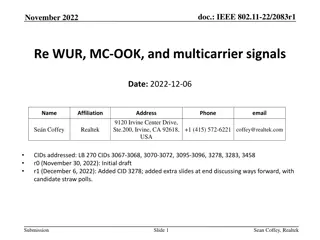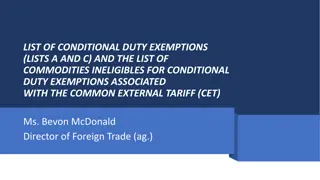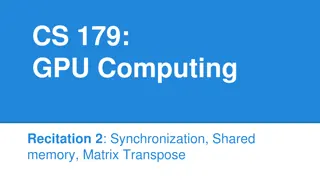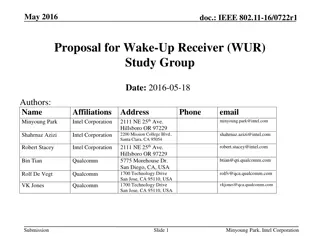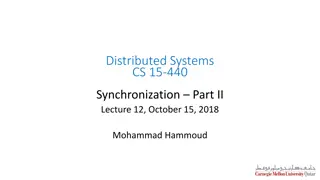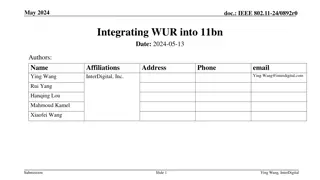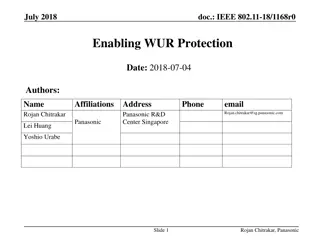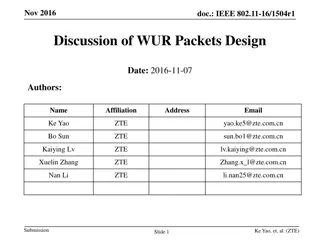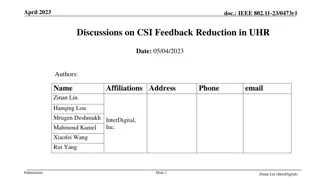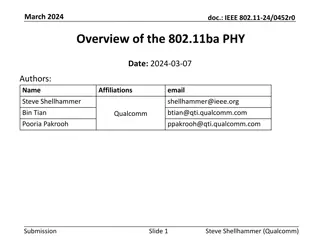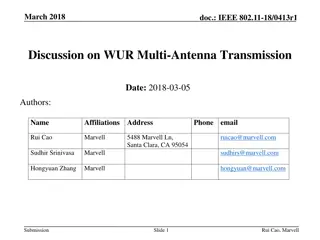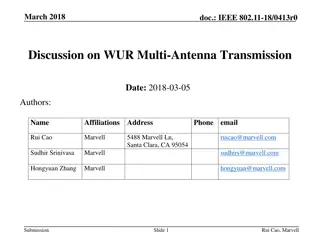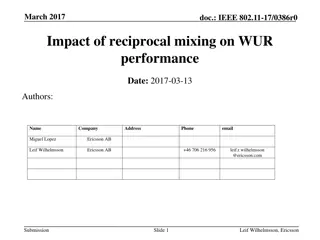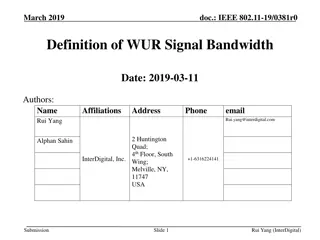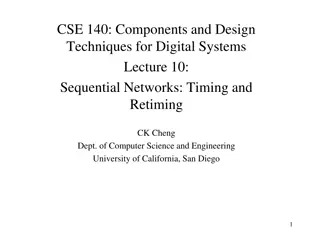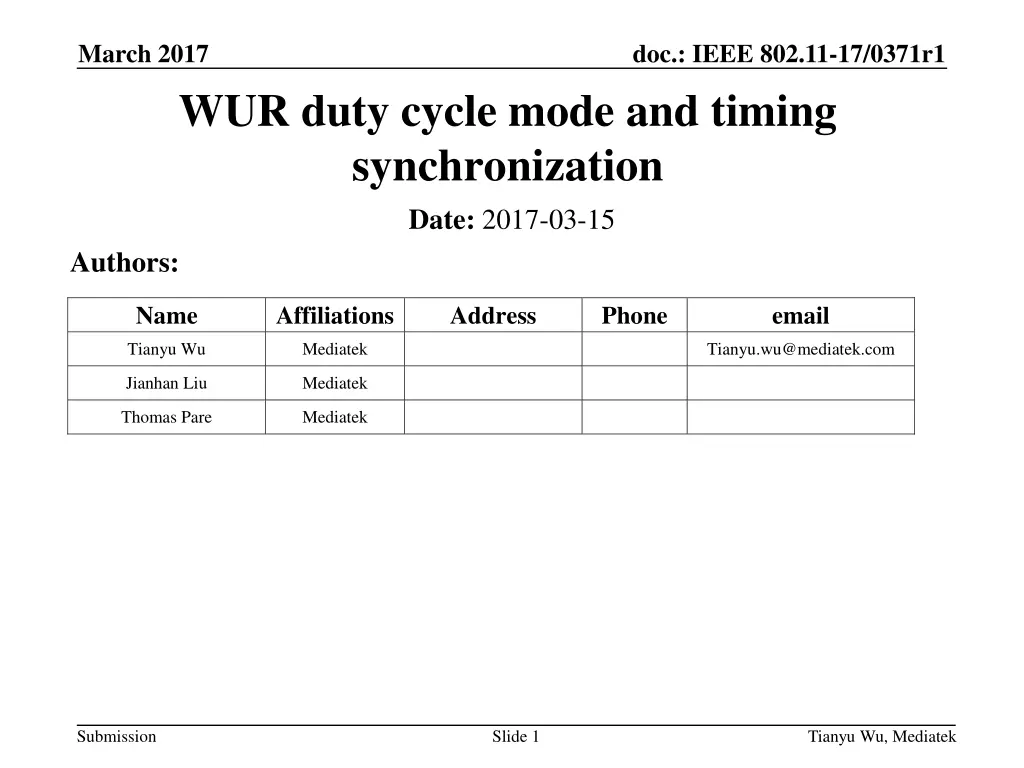
IEEE 802.11-17/0371r1 WUR Duty Cycle Mode and Timing Synchronization
Learn about the WUR duty cycle mode and timing synchronization in IEEE 802.11-17/0371r1 document. This document discusses the power-efficient operation of WUR in duty cycle mode, the timing mismatch problem, error compensation, and proposed timing synchronization solutions using SYNC signals. Find out how AP and WUR STAs interact to optimize power consumption and synchronization in wireless networks.
Download Presentation

Please find below an Image/Link to download the presentation.
The content on the website is provided AS IS for your information and personal use only. It may not be sold, licensed, or shared on other websites without obtaining consent from the author. If you encounter any issues during the download, it is possible that the publisher has removed the file from their server.
You are allowed to download the files provided on this website for personal or commercial use, subject to the condition that they are used lawfully. All files are the property of their respective owners.
The content on the website is provided AS IS for your information and personal use only. It may not be sold, licensed, or shared on other websites without obtaining consent from the author.
E N D
Presentation Transcript
March 2017 doc.: IEEE 802.11-17/0371r1 WUR duty cycle mode and timing synchronization Date: 2017-03-15 Authors: Name Affiliations Address Phone email Tianyu Wu Mediatek Tianyu.wu@mediatek.com Jianhan Liu Mediatek Thomas Pare Mediatek Submission Slide 1 Tianyu Wu, Mediatek
March 2017 doc.: IEEE 802.11-17/0371r1 Background As discussed in [1], keep WUR always on is not power efficient. To further save the power, a WUR duty cycle mode is needed. In WUR duty cycle mode, WUR STA will turn on the WUR based on a given duty cycle. AP will only send the wake up frame (WUF) within the STA s WUR on window. WUR off window WUR on window Time WUR on WUR on WUR off WUR off Submission Slide 2 Tianyu Wu, Mediatek
March 2017 doc.: IEEE 802.11-17/0371r1 WUR timing mismatch Problem The clock difference between AP and WUR duty cycle STA may lead to a timing mismatch problem. AP will send the WU frame in AP expected WUR on window of the WUR STA. However, timing of AP expected WUR on window will mismatch WUR STA s actual WUR on window in a few seconds. The timing mismatch problem will increase the missing rate of WUR frames. Some mechanisms are needed to solve this problem. WUR on windows based on AP s clock Complete Timing mismatch! Timing of AP Time Timing mismatch! Timing of STA WUR on windows based on STA s clock Submission Slide 3 Tianyu Wu, Mediatek
March 2017 doc.: IEEE 802.11-17/0371r1 Timing error compensation WUR STA can gradually increase its WUR on window to compensate the timing error. However, this will keep increasing the length of WUR on window and eventually lead to WUR always on mode. WUR on windows based on STA s clock Complete Timing mismatch! Timing of AP Timing of STA Time Timing mismatch! WUR STA gradually increase the WUR on window to compensate the timing error. WUR on windows based on STA s clock Submission Slide 4 Tianyu Wu, Mediatek
March 2017 doc.: IEEE 802.11-17/0371r1 Timing synchronization (SYNC) signal To solve the problem, AP can send a SYNC signal as a timing reference for a WUR STA. SYNC signal shall be send when WU radio is on. Based on the SYNC signal, WUR STA can adjust its starting time of the WUR on window to sync up with the AP. SYNC signal shall be some special OOK sequence to be detected by the WU radio without wake up the prime radio. However, per STA SYNC signal will become a big overhead if the number of duty cycle mode WUR STAs is large. SYNC signal Timing of AP Timing of STA Time New starting time for WUR on window Submission Slide 5 Tianyu Wu, Mediatek
March 2017 doc.: IEEE 802.11-17/0371r1 Proposed Common SYNC signal To save the overhead, AP can periodically broadcast the SYNC signal for all WUR STAs in duty cycle mode. All duty cycle mode WUR STAs shall wake up prior to the common SYNC signal and timing of next SYNC signal is estimated based on current SYNC signal. AP and all WUR STAs in duty cycle mode shall adjust the timing of following WUR on windows based on the timing of the common SYNC signal. AP may assign WUR STAs different timing offset from the common SYNC signal to avoid collision of WU frames. After each common SYNC signal, WUR STA will start the first WUR on window after the timing offset. SYNC signal Timing offset for STA1 Time AP STA1 WUR on windows STA2 SYNC detection window Timing offset for STA2 Submission Slide 6 Tianyu Wu, Mediatek
March 2017 doc.: IEEE 802.11-17/0371r1 Timing error compensation between common SYNC signals Between common SYNC signal, there still exists some timing mismatch between AP and WUR STAs. To compensate the accumulating clock difference, WUR STAs can gradually increase the length of the WUR on windows. While receiving the common SYNC signal, WUR STAs can reset the length of its WUR on window to a default value. The increasing length of WUR on window for each duty cycle can be calculated based on AP s clock accuracy and WUR STA s own clock accuracy. Time AP STA1 Increasing length of WUR on windows STA2 Submission Slide 7 Tianyu Wu, Mediatek
March 2017 doc.: IEEE 802.11-17/0371r1 WUR duty cycle mode setup To set up WUR duty cycle mode, WUR STA and AP need to negotiate on the period of WUR on windows, Timing offset etc. WUR STA can request to enter duty cycle mode by sending a request frame to AP. This WUR duty cycle request frame contains the period of WUR on window. AP response WUR duty cycle request with a duty cycle response frame In the response frame, AP can assign the WUR STA a timing offset from the common SYNC signal. AP can also indicate WUR STA the expected time to next common SYNC signal. WUR duty cycle response Expected time to next SYNC Period of WUR on window Time AP Toffset WUR STA WUR duty cycle request Submission Slide 8 Tianyu Wu, Mediatek
March 2017 doc.: IEEE 802.11-17/0371r1 Error recovery If a WUR STA in duty cycle mode failed to detect a common SYNC signal, it shall: Extend the following WUR on windows and SYNC detection windows Time AP WUR failed to detect the SYNC signal WUR STA The following WUR on windows and SYNC detection windows shall be long enough to cover all the possible arriving time of WU frames and common SYNC signals. If a number of contiguous common SYNC signals are missing, WUR STA shall enter WUR always on mode to detect the SYNC signal or even wake up the primary radio to search for the AP. Submission Slide 9 Tianyu Wu, Mediatek
March 2017 doc.: IEEE 802.11-17/0371r1 SP1 Do you agree that 11ba shall define a WUR duty cycle mode? Submission Slide 10 Tianyu Wu, Mediatek
March 2017 doc.: IEEE 802.11-17/0371r1 SP2 Do you agree that 802.11ba shall provide a mechanism to solve the timing mismatch problem in WUR duty cycle mode? Submission Slide 11 Tianyu Wu, Mediatek
March 2017 doc.: IEEE 802.11-17/0371r1 SP3 Do you agree that 802.11ba shall define a common SYNC signal for all WUR STAs in duty cycle mode as timing reference signal? Submission Slide 12 Tianyu Wu, Mediatek
March 2017 doc.: IEEE 802.11-17/0371r1 SP4 Do you agree that the following information shall be exchanged during WUR duty cycle mode setup? WUR STA shall send the period of WUR on window to the AP. AP shall send the timing offset and the expected time to next common SYNC signal to the WUR STA. Submission Slide 13 Tianyu Wu, Mediatek
Jan 2017 doc.: IEEE 802.11-17/0371r1 Reference [1] 11-17-0043-00-WUR power save mode and problem [2] 11-16-0974-00-0wur-wur-usage-scenarios-and- applications [3] 11-16-1465-00-0wur-wur-usage-model [4] 11-16-0027-00-lrlp-lp-wur-enabling-low-power-low- latency-capability-for-802-11 Submission Slide 14 Tianyu Wu, Mediatek

